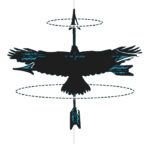How to be a farmer
Let your body learn to rise at the moment the earth anticipates sun, before liquid light leaks through the yellowed sheers and spills over the marquee flooring, and floods the empty fields surrounding the house. Allow yourself to notice your body filling with breath before that daily forgetfulness sets in. Anticipation for the day will fade with the years; this is to be expected. This morning time will never receive a name, but its hushness will welcome familiarity: the gruff brushing of the hallway carpet under your feet, the aging Mr. Coffee’s stale smell as its heating coil kicks on; grey ink smudges on your thumbs from the Columbus Dispatch that will travel with you throughout the day. Your routine will keep you until it doesn’t.
Use winter months to skim seed catalogs, to select either Big Boy and Early Girl tomatoes. Jade green beans or Sugar Snap peas. At least four different varieties of sweet corn for the truck patch: Silver Queen, Sweetness, Allure, Illusion. You’ll feel the field crop rotation pattern operate like smooth gears inside you. From the kitchen windows, watch the snow collect in the banks along the field fences and the sparrows peck at the grass shards.
Spring will require more movement but you’ll be locked into a path shaped by the rains. Gather with the other farmers at the grainery to discuss the prospects of getting into the field today or tomorrow or next week. Know that whenever you go out, it won’t be the right time. Become used to the smell of feedbags on your shirt sleeves from sitting in this dusty space.
Summer will be for crop maintenance. Scoop up soybean leaves to examine for downy or powerdy mildew. Examine the corn for diplodia ear rot. Hire the boys down the street to help with hay bailing when your arthritis locks up your shoulders and back so that stacking the bails becomes an art of the young. Sit on the porch at dusk and let your arms grow tired by the wind running past them.
Autumn will be for all harvests. The combine will grind through the fields of brown and yellow stalks and leaves. Sometimes, you’ll need to work at night, and your equipment’s lights will burn through cold shadows. When you take the grain wagons to the grainery for weighing and shipping, you’ll notice the dust that lifts off that rough food stuff as it falls through the auger. Those ephemeral particles capture the shape of air as it molds around you, draws you into the space of the land. You might try to close your calloused and dirt-smeared hands around them, once, and be surprised by the absence of their certainty.
How to gather eggs
It starts with your nose and an awareness of pungent odors: chicken feathers mixed with chicken piss. You’ll anticipate the smell approximately 5 & ½ feet from the henhouse. Stray wire prongs will grab for you from the door, so learn to grasp it above the handle with your free hand. In your other hand carry the ancient metal egg bucket, kicked in one side, with a wooden handle that still holds the impressions of some great-, great- relative. Allow the noise of 64 Rhode Island Reds to settle in the space between your ears and collar bones. Notice the hens’ call-and-response and wonder at the realization you’ll never know what they say to one another. Brush aside the cobwebs from the entrances to each laying box. Feel the old wood smoothed slick and gray from years of chickens and hands squeezing through. New straw needs to be tucked into the boxes each fall, and during these fresh months, you and the chickens will smell the sun and rain and earth above coop’s general stale rot. Roll each egg into your hands and place them one at a time in the bucket. Feel the chickens’ small eyes bead into your back as you do this. Like Colorado potato beetle larvae, nibbling systematically across a leaf, the collective gaze of these birds strips something more away each time you enter. This is good. It will teach you to pay attention when the clangor quiets, when something creeps near. In those moments will you learn to hear the crack of one egg meeting another.
—
Nicole is part of the 5th generation to grow up on a family farm in central Ohio. She lives in Newport News, VA with her husband and cat, and is an Assistant Professor of English at Christopher Newport University. She spends most of her time teaching, talking, and writing about writing.

Artwork by:
Andre Moura

This shortcode LP Profile only use on the page
Profile Artwork by: Andre Moura
Artwork by: Andre Moura
